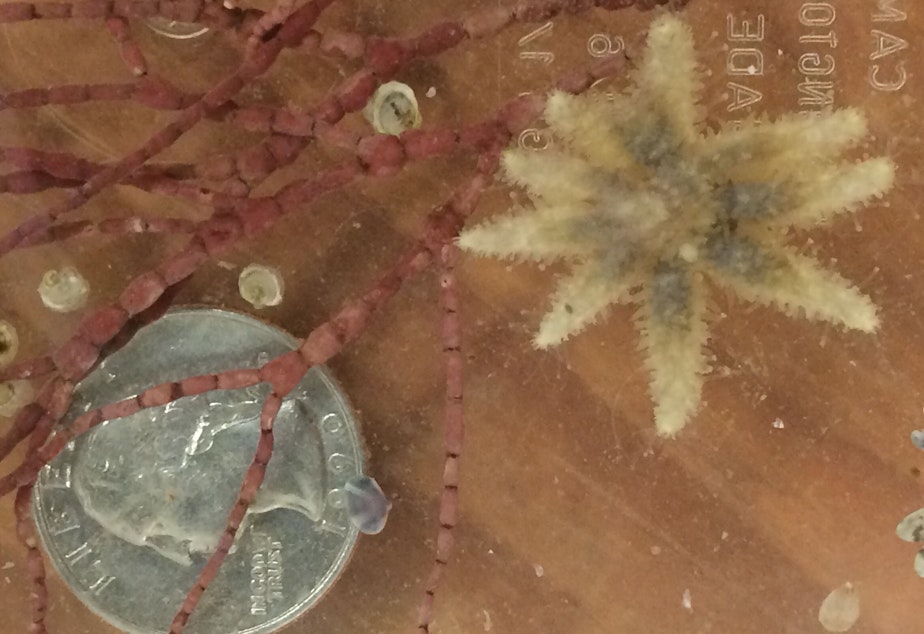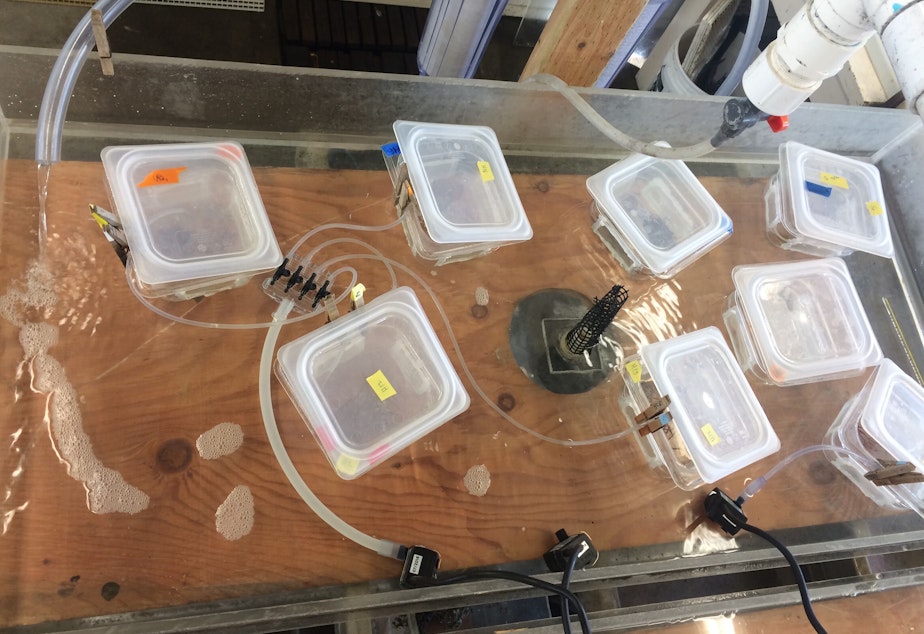After months of trial and error to find what it takes to keep a voracious, pizza-sized predator alive, biologists have succeeded at raising 14 baby sunflower stars: little bundles of hope in a dark time for their species.
Researchers at the University of Washington’s Friday Harbor Laboratories on San Juan Island have been trying to raise the spectacular, 20-armed species of sea star indoors for the past year and a half.
“I'm actually standing in a lab right now, having a look at some of our baby sunflower stars, which are about the size of a quarter,” said Jason Hodin, a biologist with the university.
The technicolor predators start out as microscopic, floating plankton, then settle down to the seabed as tiny, five-pointed stars about the size of the period at the end of this sentence.
In the lab, the starlets have grown fifty-fold in a little less than a year, adding arms as they go.
“It would be like a human baby growing to the size of a Douglas-fir tree in a year,” Hodin said. “So they've grown a lot.”

The importance of this saltwater nursery became apparent on Thursday, when the sunflower star was declared a critically endangered species.
The International Union for Conservation of Nature made the designation after determining that some 5 billion sunflower stars, or 90% of their global population, had been killed by a mysterious underwater pandemic.
A disease referred to as sea star wasting syndrome started to spread like wildfire along the west coast of North America in 2013, and has turned 20 sea star species to goo since.
Its causes remain unknown, though warmer temperatures may increase the risk of the many-armed animals dying from the disease.
No species has been devastated worse than the sunflower star, the world’s first sea star to be designated an endangered species.
The fastest and one of the largest sea stars on earth, sunflower stars could be found from Alaska’s Aleutian Islands to Baja California — until recently.
Now, they are virtually gone from the southern part of their range, with their numbers from the Olympic Peninsula to Baja reduced by 98%.

Before the wasting disease struck, the Salish Sea had more than 400 million sunflower stars, each roaming the sea floor on thousands of tiny tube feet, eating mussels, urchins and almost any animal in its path.
Five years later, their numbers had plummeted 92%, leaving an estimated 33 million of the keystone species in the inland waters of Washington and British Columbia.
Even in the lightest-hit region, western Alaska, the population has crashed by 60%.
Most endangered-species listings go to creatures that can be monitored more easily than an undersea invertebrate like the sunflower star, according to Drew Harvell, a marine ecologist at Cornell University.
“And yet in terms of ecological importance in the ecosystem, it’s often the invertebrates that are the superheroes,” Harvell said in an email.
By eating kelp-munching sea urchins, sunflower stars help maintain kelp beds and kelp forests, which are important habitats for a variety of creatures.
Overgrazing from exploding urchin populations as well as heat stress from climate change have withered many West Coast kelp beds.
“It may be you’re sort of weakening the links in the ecosystem until it’s like a game of Jenga,” said Hodin with the University of Washington. “You pull out one more piece, and the whole thing collapses.”
“For me, this has been a line in the sand,” Harvell said. “We cannot let one of our most iconic sea star species, that is endemic to the entire Pacific coast, seen nowhere else on the planet, blink out without a big fight.”

Hodin’s lab in Friday Harbor has a colony of 30 sunflower stars, collected from the San Juan Islands, living in tanks of filtered seawater.
Their coin-sized offspring live in ordinary plastic food-storage tubs.
To let water flow through, Hodin hot-glued mesh screens onto holes he cut in the tubs’ sides.
“Friday Harbor Labs is kind of famous for this,” Hodin said. “If you peeked into the labs here, you’d see everybody MacGyvering things together in some way.”
“How do you get a sunflower star to spawn?” I asked Hodin and got a very unexpected answer in return.
Sometimes, it turns out, to help save a critically endangered species, you have to cut off one of its arms.
“There are gonads in every single one of the arms,” Hodin said.
By amputating one arm, researchers can harvest the sperm or eggs in it to breed a new generation. The missing arm grows back.
In the wild, sunflower stars spew sperm and eggs into the water each spring to reproduce.
Researchers first tried a less-invasive technique of injecting a sea star hormone into the animals to stimulate development of sperm and eggs. That didn’t work.
So amputation it is.
“This is something that happens naturally to sea stars in the field,” Hodin said. “They’ll drop their arms the same way a lizard drops a tail under a predation threat.”

Hodin said sunflower stars are famous for their ability to regenerate missing body parts.
“This fact was discovered by fishers who used to cut them in half to kill them, only to find twice as many starfish growing new legs the following year,” according to the Alaska Department of Fish and Game.
Hodin said he hopes to raise a few hundred young stars next year and to get other labs doing the same. But it could be a long time before any are reintroduced to the sea.
With the cause of the wasting disease still a mystery, putting lab-raised animals into the wild could risk spreading a pandemic.
“Ecologists, you know, we have our own Hippocratic oath, of ‘first, do no harm,’” Hodin said.
For now, reintroduction is a long-term vision, and the focus is on learning to raise the stars in larger numbers.
Raising sunflower starlets has already yielded new knowledge on the animal’s life cycle that should help any future conservation efforts.
DNA from those severed arms is being sent to University of California researchers for analysis of the sunflower star genome, information that might help unravel the mystery of the world’s worst underwater pandemic.

December 14, 2020 at 07:12AM
https://ift.tt/2Ly3f3g
These 14 baby sea stars are tiny bundles of hope for their critically endangered species - KUOW News and Information
https://ift.tt/2CoSmg4
Sea

/cloudfront-us-east-2.images.arcpublishing.com/reuters/CZF6NULMVVMEXHOP7JK5BSPQUM.jpg)
No comments:
Post a Comment